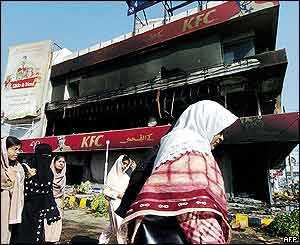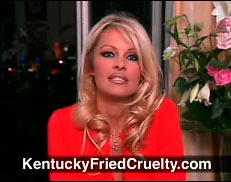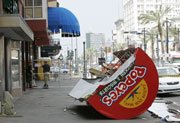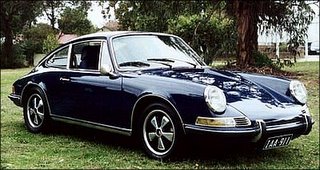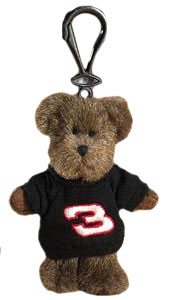Understanding the AT&T v. Nascar Litigation
In 2000 the wireless communications company Alltel began its relationship with Penske Racing South to sponsor the 12 car. Sometime in 2001, Cingular LLC—a joint venture between and thus owned by SBC Communications and BellSouth—began a relationship with Richard Childress Racing and became the primary sponsor of the 31 car for the 2002 season.
In the latter half of 2003, Nascar and Nextel began to formalize the agreement by which Nextel would become the cup series’ title sponsor for 10 years. Nextel wanted to be an aggressive and integrated sponsor for the series, and unveiled its plan to develop a new wireless information and communications device that Nascar fans could use at cup series races to follow the action and listen to communication. Nextel offered to pay Nascar $750 million to become the cup series title sponsor, but for this, demanded that Nascar sign an exclusivity agreement making Nextel the only wireless communications provider associated with events at the track during cup races. (The agreement would not affect television advertising).
Nascar made it clear to Nextel that while it did not have a problem granting exclusivity going forward, it was uncomfortable both legally and personally with the idea that the exclusivity agreement would supplant the sponsorships existing at RCR and Penske. Through discussions, it was determined that the parties agreed to allow the existing sponsorships to continue—and even be extended—provided that the sponsor remains with the same car, and does not increase “its position” on the car (meaning that if the sponsor is a secondary sponsor, it cannot become a primary sponsor).
After these discussions, Nextel’s sponsorship of the cup series was finalized, including an exclusivity agreement wherein Nextel was named exclusive wireless communications sponsor of the cup series beginning in 2004 and Nascar agreed to forbid any sponsorship participation by Nextel’s competitors, which were listed by name in the exclusivity agreement and included Cingular, Alltel, AT&T, Sprint, Verizon, etc. The Nascar/Nextel agreement noted that it was subject to the grandfather agreement that would be executed between Nascar and its race teams with existing telecom sponsors, and provided that Nextel recognized that existing agreements between teams and “sponsors” would be allowed to continue.
Nascar isn’t a party to raceteams’ sponsorship agreements, but Nascar requires car owners and drivers to sign annual “Driver and Car Owner Agreements.” The grandfather agreement between Nascar and the teams with existing telecom sponsorships was incorporated into the Driver and Car Owner agreements beginning in 2004. It provided an exception to the exclusivity agreement that, as discussed, is entirely phrased in terms of “existing product licensing relationships” and allows “the sponsor” to remain as long as the sponsor remained with the same car and did not improve its position on the car. Nascar also alleges that it advised Cingular and RCR that “third-parties” would not be allowed to join the sponsorship by buying Cingular. There is some debate over what was actually said.
The annual agreements also clearly provide that all activity is subject to Nascar’s rule book, which gives Nascar broad discretion to regulate the sport, and expressly includes Nascar’s right to govern what advertising and paint schemes are allowed on the track. Nascar makes all drivers, owners and series’ sponsors annually agree to be bound by the Nascar rule book. This included Cingular, which also agreed to be bound by Nascar’s rules.
In 2005, SBC Communications acquired AT&T. However, to capitalize on the worldwide brand recognition of AT&T, SBC changed its name to AT&T. Concerned about these developments, Nextel pressured Nascar to notify RCR that Cingular would not be permitted to change its brand name or logo. Nascar sent a letter to RCR advising it of this in April, 2005. In late 2006, SBC Communications (now AT&T) merged with BellSouth. The resulting company kept the name AT&T, but since Cingular LLC was no longer a joint venture (as its two owners were now merged), AT&T desired for all the companies to have the AT&T brand. It then legally changed the name of Cingular LLC to AT&T Mobility LLC and began the transition from the Cingular name and logo to the AT&T name and logo in its worldwide wireless activities.
In preparation for the 2007 cup season, Cingular (now AT&T Mobility) exercised its right in the sponsorship agreement with RCR to determine the name and logo on the 31 car, and submitted a new paint scheme featuring the AT&T name and logo. RCR submitted the new scheme to Nascar, which rejected it. Nascar advised RCR and AT&T Mobility that it held the right under the rules to make paint scheme decisions and that it was precluded by the exclusivity agreement from allowing the AT&T name and logo. Nascar told RCR and AT&T Mobility that the grandfather agreement didn’t allow a name change and that it had advised them that new third-parties would be allowed to join the sponsorship.
In March 2007, AT&T Mobility filed suit against Nascar alleging that it was not a third party to the sponsorship agreement or the grandfather agreement, and that it was allowed under the law to change its name without affecting its contractual rights, and that the grandfather agreement did not limit “the sponsor” to a particular name or logo. Thus, AT&T argued, Nascar was violating its contractual rights by requiring that only the Cingular name and logo could appear on the 31 car. AT&T argued that it was being damaged by Nascar’s refusal because it inhibited its brand transition and was likely to confuse race fans because Cingular appeared to still be an active brand when it was not.
Nascar responded that it had broad discretion under its rule book to regulate advertising on cup cars and it was exercising this discretion by keeping the AT&T logo out of cup racing. Nascar also alleged that it advised Cingular and RCR on numerous occasions that it could not change the brand name on the 31 car.
The federal judge in Atlanta, where the suit was filed, issued his ruling on May 18, granting AT&T Mobility an injunction that temporarily ordered Nascar to allow the AT&T name and logo. Judge Shoob found, preliminarily, that the grandfather agreement did not limit Cingular’s sponsorship rights to a specific name or logo, and that AT&T Mobility was not a third-party, but instead Cingular, with the same ownership but only with a new name. The judge agreed that AT&T Mobility was being damaged by Nascar’s refusal to allow the change and that it was likely to cause confusion in the marketplace. With regard to Nascar’s rule book, the judge found that the general rule that Nascar has the broad discretion to govern advertising is trumped by the specific agreement to allow Cingular’s sponsorship rights to continue.
A preliminary injunction does not mean the case is over. And it does not mean that the judge will maintain his position on the issues influencing his decision to award the injunction. It only serves to establish certain rights—based on a specific showing of certain factors—to be in place while the full litigation continues. Nascar appealed the judge’s ruling to the U.S. Court of Appeals for the 11th Circuit, but it was denied.
Thus, the litigation continues, with the preliminary injunction in place. For now, AT&T Mobility can use its logo on the 31 car. AT&T must feel pretty confident about its chances in the litigation because it just announced a sponsorship extension with RCR to sponsor the 31 car through 2010. It is unknown whether the extension is contingent on any specific result in court. Also this week, Nascar countersued AT&T for $100 million for interfering with its sponsorship with Nextel and for failing to honor its commitment to follow Nascar’s rule book, which gives the body broad discretion to govern the sport. Nascar also asked the court to rescind the grandfather agreements and force non-Nextel telecom sponsors out by 2008. Given that this is now a full blown corporate litigation, it is unlikely that the trial court will come to any complete disposition of the case anytime in the near future. The case must now either be ruled on by a summary judgment motion, a trial verdict or be settled by the parties.
Personally, I don’t think this case is all that unique, and I don’t think Nascar realizes that. In our society, rights and obligations are determined by law and by contract. And there is a complete body of law and principles that govern how these disputes are to be determined. Speaking generally, here are 5 general principles that matter in this case:
1. Companies are allowed to change their names without affecting their contractual rights or obligations, unless those rights or obligations are specifically limited and prohibit the company from changing its name.
2. When it comes to interpreting contracts, the “letter of the agreement”—that is, what the words actually say—is generally given the most weight. Evidence about conversations, or one-sided writings such as letters, are considered “collateral” and generally will not modify that which is contained in the written word of a contract.
3. Once written contracts are finalized, they cannot be modified without the written agreement of both parties to effect a modification.
4. When conflicting provisions within a contract, or multiple contracts or agreements are involved, a specific clause or provision is generally given more weight than a general clause or provision. When two provisions are in apparent conflict, the specific provision trumps.
5. A party generally cannot be found liable for damages to another as the result of the party’s action that was specifically ordered by a court.
When you look at this case with these principles in mind, it is difficult to see how Nascar can prevail. If the court finds that AT&T Mobility is simply Cingular by a new name—and the facts currently known strongly suggest that because AT&T did not buy its way into Cingular, rather Cingular’s owners themselves bought AT&T—then the idea that AT&T is a third-party is out the window. The question is then what rights does Cingular have to change its name to AT&T and determine the appearance of the 31 car based on its sponsorship. The grandfather agreement does not limit Cingular to a specific name or logo and only refers to “the sponsor.” Therefore by the general principle, Cingular has the right to change its name without affecting its contractual rights. A name change does not appear to matter under the grandfather agreement so long as the company (“the sponsor”) remains the same. (It is unlikely that any court would interepret “the sponsor” to mean a specific name, it instead refers to a company and companies are normally allowed to change their name).
So it appears that the grandfather agreement doesn’t limit Cingular to a specific name or logo. Nascar will allege that it told Cingular and RCR that it could not change the sponsor’s name but there are two problems with that. First, if Nascar told Cingular and RCR about this before the grandfather agreement was finalized, why isn’t it written in the agreement? Again, the word of a written agreement will prevail over other evidence. And secondly, if Nascar told them after the agreement was finalized, it is a modification that must be agreed upon and written—and there is no evidence that such an agreement to modify was ever made.
What might be most difficult for Nascar to accept is that it doesn’t have unlimited discretion to govern the sport by mere operation of its rule book. By operation of these legal principles, Nascar’s general rule that it maintains all discretion to determine advertising is trumped by the specific grandfather agreement. This must be the case because otherwise, if Nascar always had the right whenever it wished, to keep Cingular off the 31 car, then the entire set of agreements would be meaningless. If Nascar is going to be party to contracts, those contracts must be given effect—Nascar can’t maintain the option to render them meaningless whenever it so chooses. Our system doesn’t work that way.
As far as Nascar’s claims, they are also likely to be rejected. Nascar claims to have been damaged by $100 million by AT&T’s participation and desire to be allowed to put its name and logo on the 31 car. AT&T’s participation in cup racing since the All-Star race was done so by express operation of a federal court order. Nascar is not entitled to damages for AT&T’s activity expressly ordered by the court. Secondly, aside from attorneys’ fees and costs, a party is not entitled to claim damages that result from another party’s lawsuit asking the court to determine relevant rights and obligations under the law. AT&T’s lawsuit cannot be the basis of contractual interference with the Nextel sponsorship.
With regard to Nascar’s request to kick all telecom sponsors out by 2008, I wouldn’t worry to much if you’re a Ryan Newman fan. The fact remains that Nascar gave these telecom companies rights in the grandfather agreement, and so long as that agreement remains in effect, Nascar can’t unilaterally rescind the agreement and it is unlikely that the court will simply throw out the grandfather agreements just because Nascar wants it to. There has to be a legitimate legal reason to undo the grandfather agreements and I haven’t yet seen that Nascar has a basis to make this demand.
At the same time, I’m not so sure that Nascar should be all that afraid of what Nextel might do. If Nextel knew about the language of the grandfather agreement, and even consented to it, Nextel has no claim that Nascar has fouled here. In fact there was express reference to it in the Nascar/Nextel agreement. In this situation, it doesn’t seem like Nextel will have much success at arguing that Nascar failed to protect its exclusivity when Nextel was aware of the grandfather agreement and its language and made no protest. If the court finds that AT&T can participate in cup racing by operation of the grandfather agreement, Nextel isn’t going to have much of a case against Nascar.
BUT- this lawsuit shouldn’t be groundshaking to the world of Nascar. The principles of our general legal system have always been an underlying part of Nascar. Just as Nascar couldn’t sell crack at the racetrack to spectators just because it wants to, the law also prevents Nascar from entering contracts and then not abiding by them. Nascar has the right to grant exclusivity agreements and grandfather agreements, but when those agreements are subject to dispute, Nascar is going to be bound by the commercial laws of this country. This is nothing new.
Nascar will still have discretion to run the sport and enter into whatever agreements allowable by law. Nascar can still have its rule book. But those rules and Nascar’s authority will be subject to modification by the contracts that Nascar enters. Nascar has become a rich, powerful entity. But it needs to learn, and I think that this lawsuit is going to teach it, that often in business, you’re only as good as your lawyers. If Nascar and Nextel wanted to limit Cingular to a specific name and logo, all it had to do was say that in the grandfather agreement. It is just that simple. Had it done that, none of this would have happened. But at the same time, you have to live with your mistakes and learn from them.
Just my take at the present time, based on what has been filed.
